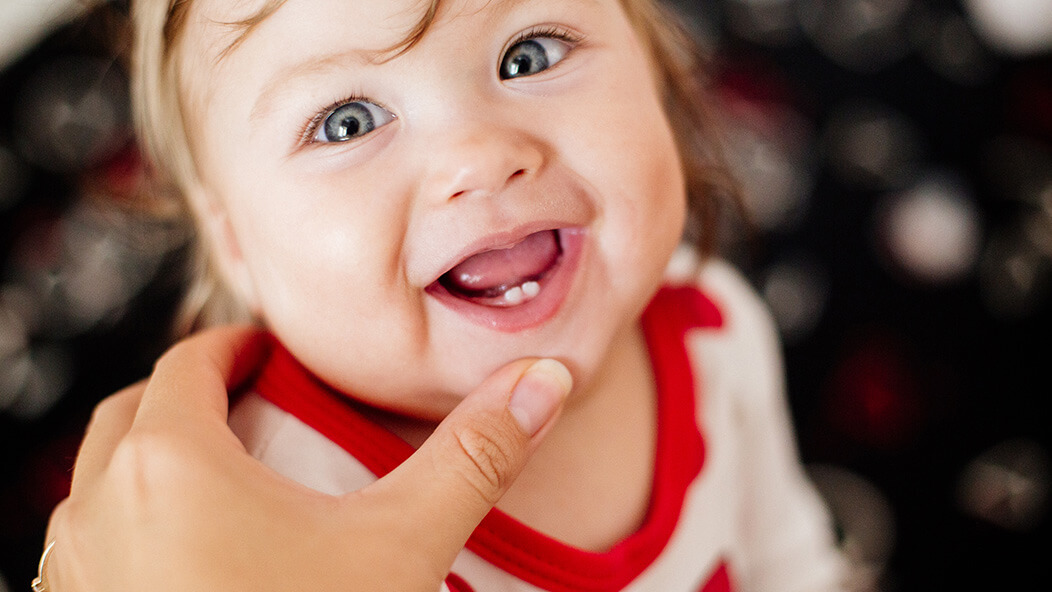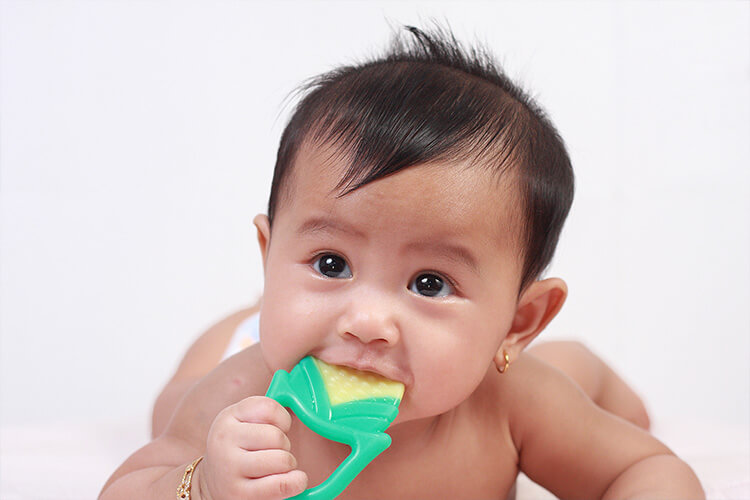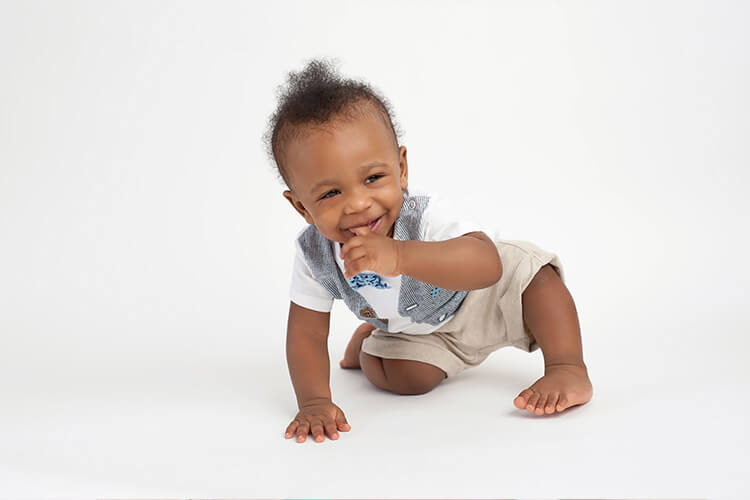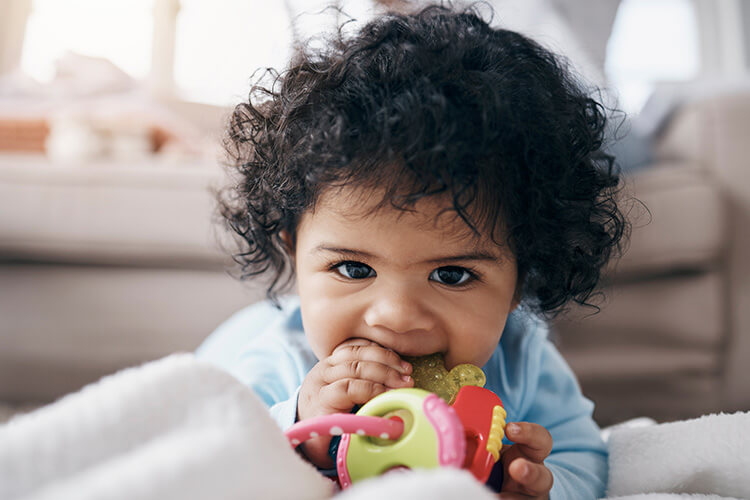Join Our eNewsletter!
Subscribe to our monthly newsletter to receive encouraging advice to help you lead a healthy lifestyle.

The Truth About Teething
Your baby has been a smiley bundle of joy almost since birth. Then one day, your sweet little angel is cranky and almost inconsolable. That’s when you realize that they’re experiencing one of the many firsts of childhood – their first tooth. For new parents, it can be difficult to determine if their baby’s symptoms are a result of teething or something else. The question I get most often from parents with teething babies is, “Is this normal?”
To help answer that question, here’s some guidance on what to expect during teething and what parents and caregivers can do to safely soothe their baby as their pearly whites start to make an appearance.
The Typical Stages of Teething
Babies are born with all 20 primary or baby teeth under their gums. On average, babies begin teething between four and six months of age, but the first tooth or teeth can begin erupting (breaking through the gums) at any time during infancy.
A child’s teething timeline is generally tied to genetics, but most babies get two new teeth every two to four months until they’re around 3 years old. If your child does not have any teeth come in by 16 months of age, you should consult with your pediatrician.
Stage 1 – 0 to 6 months: Babies may begin drooling quite a bit starting around 3 months old, but this may not be solely due to teething. Drooling is also a normal part of an oral sensory phase. They may begin putting their hands and items in their mouths regularly. But teeth generally don’t start erupting until six months.
Stage 2 – 6 to 8 months: Around 6 months to 8 months old, the first tooth usually breaks through the gums and it’s normally a lower front (central) incisor. An upper front (central) incisor may also come in during this time.
Stage 3 – 8 to 14 months: The remaining upper and lower (lateral) incisors usually erupt, and the first molars may also come in at this time.
Stage 4 – 14 to 24 months: Between a child’s first and second birthday, the upper and lower canine teeth usually erupt.
Stage 5 – 24 to 36 months: By the time a child is 3 years of age, they have typically had all of their primary or baby teeth erupt, with the last teeth being their second molars.

Normal Signs and Symptoms of Teething
Teething is not a pleasant experience for babies (or parents!) and most children exhibit common signs and symptoms throughout the teething process, particularly when teeth are erupting through the gums, which generally takes about eight days per tooth.
The classic signs and symptoms of teething are:
- Excessive drooling (and possible facial rash as a result)
- Irritability, crankiness, and fussiness
- Tender, swollen gums that may also be slightly red
- Chewing or sucking on hands or objects
- Rubbing the cheeks or ears
- Flushed cheeks
- Trouble sleeping (although some children may sleep more)
- Refusing to eat or drink
- Coughing (typically due to excess saliva in the throat)
Many parents are adamant that their children experience fever or diarrhea during teething. While a slight increase in temperature may be associated with teething, a fever of 100.4 or higher likely means something else is causing the elevated temperature. There doesn’t seem to be a direct correlation between teething and diarrhea, though some pediatric specialists surmise that excessive saliva making its way to the gut could cause loose stools.
Signs that are NOT a normal part of teething include any blood or pus in the mouth or on the face, swelling of the face, inconsolable crying lasting much longer than usual, and a runny or stuffy nose not related to crying.

Unsafe Teething Pain Treatments
There’s nothing worse than seeing your child in pain, but it’s vitally important for parents and caregivers to be mindful of safety when choosing how to soothe a child’s teething discomfort.
Some medications and products designed for teething that can actually pose a danger to children include:
- Jewelry marketed for teething, including necklaces and bracelets made of amber, wood, marble, or silicone, can be a choking hazard because pieces can break off while the child is chewing on the jewelry. Necklaces can also result in strangulation. Some bracelets sold as homeopathic teething bracelets have been linked to lead poisoning because the metal beads on them contain lead. For safety’s sake, it’s best to avoid any jewelry for teething, even if it’s marked as a teether.
- Topical benzocaine anesthetics, such as Orajel (nonmedicated Baby Orajel doesn’t contain benzocaine), can be harmful because swallowing them can suppress the throat’s gag reflex and because they can lead to a serious condition called methemoglobinemia, which reduces the oxygen-carrying capacity of red blood cells, resulting in seizures and difficulty breathing.
- Homeopathic teething tablets have been found to contain, according to the FDA, “inconsistent amounts of belladonna, a toxic substance,” and the body’s response to belladonna in children under 2 years old is unpredictable, so these tablets should be avoided.
How To Safely Soothe Teething Pain
For baby’s teething pain, there are some tried and true remedies that pediatricians and pediatric dentists agree are much safer options than the methods mentioned previously. When in doubt, always check with your child’s doctor about which methods are best for your baby.

- Massaging the gums – Since the majority of teething pain is associated with the tooth erupting through the gums, one of the best ways to soothe the pain is by gently massaging the gums. You can do this by using your clean finger, a moist gauze pad wrapped around your finger, or a small, cooled (not frozen) metal spoon. Never leave the gauze or spoon in your child’s mouth or hand, as they could choke on these items.
- Offering something to chew on – Giving your child a safe object to chew on allows them to massage their own gums, in a sense, and provides comfort. There are a number of safe, non-toxic teethers on the market. Those made of natural rubber and food grade silicone are the safest, but no matter what the teether is made of, avoid ones filled with liquid and ones that use batteries, as in both cases the teether can break open and cause the liquid or batteries to make their way into the child’s mouth. A washcloth is also a safe option. If possible, chill (but don’t freeze) the teether or washcloth before giving it to your child since the cooling sensation aids in reducing pain. Always be sure the object is clean before giving it to your baby.
- Teething biscuits – These soft biscuits designed to soothe gums, satisfy a child’s urge to bite, help babies learn how to feed themselves, dissolve in the mouth, and don’t crumble or crack. However, to stay on the safe side, they should only be given to children over six months old who have started eating solid foods. You should also opt for unsweetened or sugar-free biscuits since those with sugar can contribute to cavities. It’s advised to not use other types of foods for teething because they may not dissolve like teething biscuits and could be a choking hazard.
- Children’s pain medication – Particularly if other safe methods don’t soothe your child’s teething pain, you can give them an over-the-counter children’s pain medication, such as acetaminophen (Tylenol) or ibuprofen (Motrin) for infants over 6 months of age. But always follow the label’s instructions for your child’s age and weight and be sure your pediatrician has deemed the medication safe for your child.
Caring for Your Child’s New Teeth
Before teeth begin erupting, run a soft, clean cloth over your baby’s gums twice a day to keep food and bacteria from building up in the mouth. After the first teeth come in, use a small, soft-bristled baby toothbrush to clean them. If you use fluoride toothpaste, don’t use any larger than a dollop the size of a grain of rice until your child is at least 2 years old. After 2 years of age, children can use fluoride toothpaste that is the size of a pea. Talk to your pediatrician about when to begin taking your child to a pediatric dentist for regular dental checkups, typically after 12 months of age.








